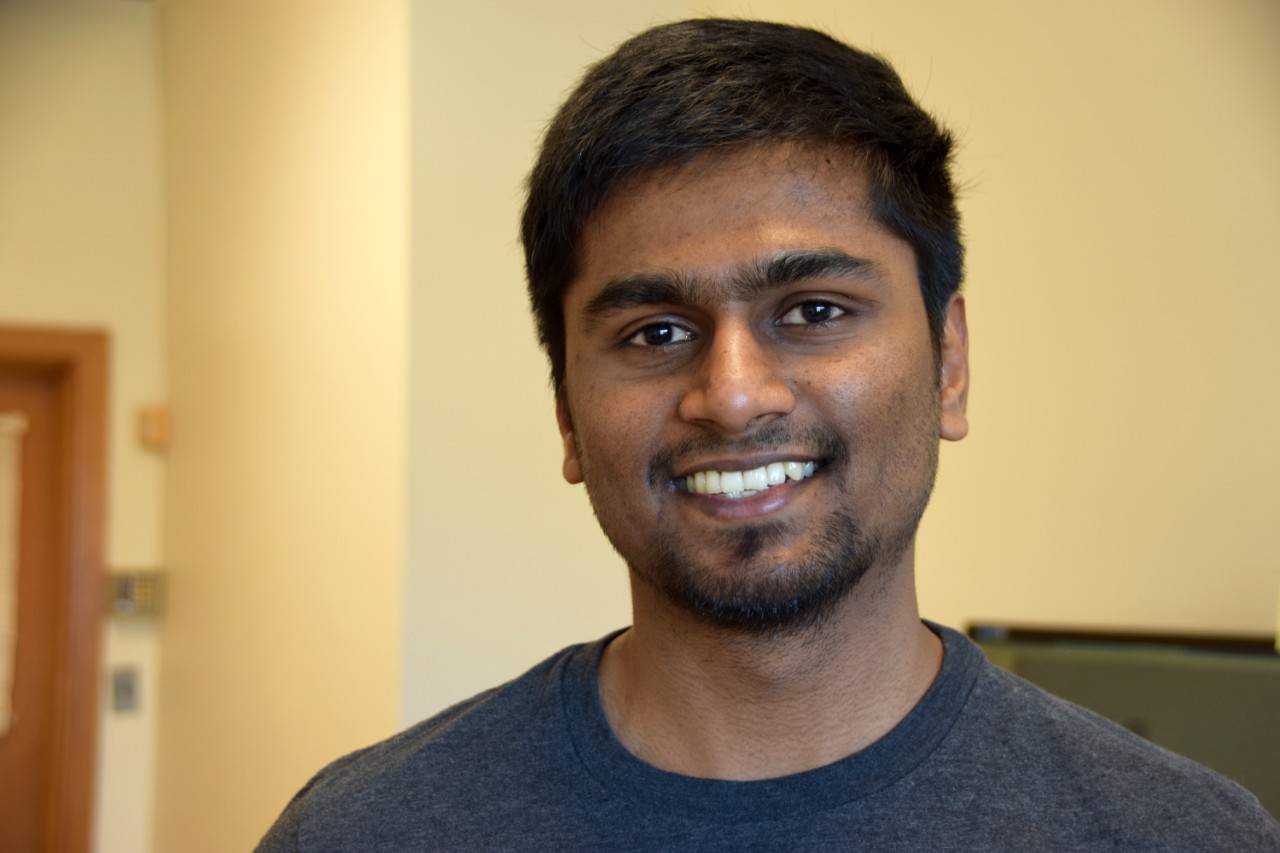
Printing hearts and handshakes
CEAS student Vishnu Viraliyur Ramasamy works with 3D printing to provide affordable prosthetics and models for practice surgeries
By Danniah Daher
Vishnushankar Viraliyur Ramasamy designs and prints prosthetic limbs. You read that right—prints prosthetics.
Vishnu (as he introduces himself) is a mechanical engineering student at UC’s College of Engineering and Applied Science, who works for EnableUC, a student organization founded at the University of Cincinnati that utilizes 3D printing to “bridge the gap between engineering and medicine.”
Their mission is to use engineered technology to create more affordable prosthetic options for patients. According to their website, they “design, build and implement solutions” in “cases ranging from pediatric prosthetics to assistive devices for traumatic brain injury.”
Read a feature story on one of their clients, 4-year-old Ella Morton, whose $20 prosthetic from EnableUC enabled her to play and ride her scooter with all the other neighborhood kids. If not created through 3D printing, Ella’s prosthetic could have cost upwards of $10,000.
Why is 3D printing so affordable? And what exactly is 3D printing?

A 3D printed prosthetic hand.
The simplest explanation is that 3D printing (also called additive manufacturing) is the process of creating three-dimensional solid objects from a digital file. The multidimensional object is made by adding (hence the name ‘additive’ manufacturing) successive layers of material until the desired object forms. And why are 3D printed goods surprisingly so cheap? Ella’s prosthetic hand was created with acrylonitrile butadiene styrene — a durable, yet inexpensive plastic.

A desk-sized 3D printer.
The magic is in the machine. The bigger the 3D printer volume, the bigger the products printed. There are 3D printers the size of an apartment, and 3D printers that can fit on a desk. While many patents have been made in the 3D printing world, Vishnu believes the perfect design has yet to be achieved.
“There’s so many different ways to design and build these machines,” Vishnu explains. “That’s what I want to perfect, or at least hope to do.”
Vishnu worked in two labs conducting research on 3D printers — three labs if you include his own apartment. He says his home is littered with 3D printer parts, which he is constantly manipulating and engineering.
“What I’m truly interested in is the mechanics of the machines, how everything works,” he says. “All I do is build the 3D printers in my apartment, and then take them apart, and then rebuild them, and then take them apart, and then rebuild them.”
Vishnu’s website details his latest 3D printing adventures and documents his personal successes and mishaps, like this 3D print gone wrong. Among the examples are a prosthetic he made for a patient with an amputated wrist, his work with custom non-commercial 3D printers and his design experience traveling to India to compete in a national racing event for which he and his team designed an actual racing car.
In one of his favorite projects, Vishnu worked with the Cincinnati Children's Hospital Heart Institute, printing life-like human hearts. They take the hearts, which are made of muscle-like material, and practice their complicated surgeries on the fake organs before the real procedure happens. Vishnu has printed everything from a custom tumor-infected heart to a large batch of generic hearts used for research purposes.
“When you are printing such complex shapes in a single process,” Vishnu explains, “You can print exactly what you want.”
What’s more, 3D printing is not exclusively for medical devices. One can 3D print nearly anything. Vishnu recently printed a new lampshade as a gift that has little floral cut-out designs that create a beautiful pattern effect all over the room. He’s also printed small action figures, an iPhone stand, and more knickknacks just for fun.
“You can do so much with these machines, and I’m really excited to see where they take me,” he says. Vishnu plans on continuing his 3D printing journey beyond UC and pursuing 3D printing companies full-time.
“I’m lucky enough to have found what really interests me. All I want to do is design these machines in the best way possible and keep improving them.”
Related Stories
UC launches Bearcat Affordability Grant
January 7, 2026
The University of Cincinnati is making college more attainable for students across Ohio with the creation of the Bearcat Affordability Grant. The new grant will provide a pathway to tuition-free college for students of families who make less than $75,000 per year. Beginning in fall 2026, the Bearcat Affordability Grant will cover the remaining cost of tuition for Ohio residents who are Pell eligible.
How aerospace is turning to trustworthy AI
January 6, 2026
UC College of Engineering and Applied Science graduate Lynn Pickering talks to the Ohio Federal Research Network about her research into artificial intelligence and the future of AI in aerospace engineering.
UC biochemistry student explores world of taste
January 5, 2026
A University of Cincinnati biochemistry student changed her career trajectory after being inspired by internships with a European Fortune 500 company.
4 reasons lifelong learning can transform your 2026
Upskilling
Discover why lifelong learning is essential for your personal growth, career advancement, and overall well-being. Explore four key benefits and get inspired to continue learning throughout your college, career, and life journey.
Engineering professors studying how co-op impacts student journey
January 5, 2026
Cedrick Kwuimy, associate professor educator in the Department of Engineering and Computing Education at the University of Cincinnati College of Engineering and Applied Science is studying how a student’s first co-op experience impacts the remainder of their journey as an engineering student, and how educators can better prepare them for these experiences. Kwuimy and his collaborators have received a three-year grant from the National Science Foundation (NSF) to support this research.
Study finds police officers face higher long-term health risks
January 2, 2026
J.C. Barnes, a University of Cincinnati professor, is interviewed by Spectrum News about new research showing that the physical and psychological demands of law enforcement can contribute to earlier deaths.
